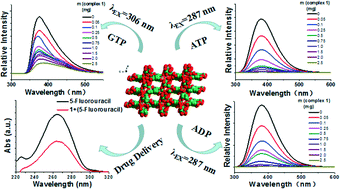A Zn(ii) complex with large channels based on 3′-nitro-biphenyl-3,5,4′-tricarboxylic acid: synthesis, crystal structure, fluorescence sensing of ATP, ADP, GTP, and UTP in aqueous solution and drug delivery†
Abstract
A new coordination complex, namely, [Zn7L2(HL)2(OH−)4(H2O)2]·2H2O (1) [H3L = 3′-nitro-biphenyl-3,5,4′-tricarboxylic acid] was synthesized by a solvothermal reaction. Complex 1 has a 3D open framework with heptanuclear cluster [Zn7O2(OH)4] secondary building units (SBUs) and features an unexpected large porous structure with a pore size of 16.5 × 19.5 Å2, which shows 37.0% porosity as calculated by PLATON. Adenosine triphosphate disodium salt (ATP), adenosine-5′-diphosphate disodium salt (ADP), guanosine 5′-triphosphate (GTP), or uridine 5′-triphosphate (UTP) was discriminated from other phosphate anions using fluorescence spectral analysis by adjusting the excitation wavelength at 287, 287, 306, or 337 nm. Complex 1 showed fluorescence sensing of ATP, ADP, GTP, and UTP in aqueous solution. In addition, complex 1 also exhibited a remarkable capacity for the anticancer drug 5-fluorouracil (5-FU), with a loading content of 46.5 wt%, and presented a slow controlled drug release.



 Please wait while we load your content...
Please wait while we load your content...